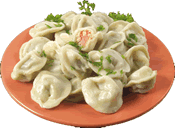
Characters in the novels by Andrey Kurkov (Андрій Юрійович Курков) that I’ve read recently often enjoy a bowl of dish of pelmeni, which is obviously some kind of food, but is not translated. I wondered what pelmeni might be, so thought I’d find out.
According to Wikipedia, pelmeni are “dumplings consisting of a filling wrapped in thin, unleavened dough that originated in Siberia”. The dough is made of flour and water, with eggs sometimes added, and the filling is minced pork, lamb, beef, mutton or other meat, mixed with pepper or other spices and onions, or with fish or mushrooms. They are cooked by boiling them in water or broth, or by frying.
In Russian they are known as пельмени (pel’meni – pl) / пельмень (pel’men’ – sg), in Belarusian they are пяльмені (pyal’meni), in Ukrainian they are пельмені, (pel’meni), and in Latvian they are pelmeņi. The name comes from пельнянь (pel’nyan’), which means “ear bread” in the Komi, Udmurt, and Mansi languages.
According to the School of Russian and Asian Studies Russian pelmeni (русские пельмени) come from Siberia and the word comes from Komi, though the receipe might originally come from China. They certainly sound like to Chinese 餃子 (饺子) jiǎozi.
Here are some pelmeni recipes:
http://tasterussian.com/russian-pelmeni-recipe.html
http://www.russianfoods.com/en/pelmeni/
http://www.ruscuisine.com/recipes/breads-and-pastry/dumplings/n–524
Are you a fan of pelmeni, or do you have something similar in your country?
Oh yes! These are my friend’s favorite dish in the Chinese restaurant. In the menu they are “chicken dumblings”. There is also “beef dumblings” but I don’t know why they just don’t call it so, but instead they call it Shao-Mé or something that sounds like that.
In Korea, we eat mandu
In Tibetan they are called momo[s] མོག་མོག། They are usually filled with minced beef or cabbage and served with a very spicy dipping sauce.
When I was in Russia, I ate this almost every day. The easiest lunch to prepare in six minutes without a microwave oven. There are also specialised restaurants called пельменная serving simple cheap dishes, mostly pelmeni.
A similar dish, вареники, is also popular in Russia, although it is associated mainly with Ukrainian cuisine. Вареники are filled with fruit or marmalade.
In Tamil Nadu (Southern India), we make steamed sweet/savoury delicacies called ‘கொழுக்கட்டை’ (kozhukkaTTai) which are commonly prepared as an offering to piLLaiyAr (Lord gaNEsha) during His festivities. In Sanskrit, they are known as ‘mOdaka’ and one of Lord gaNEsha-‘s common epithets is ‘mOdaka-priya’ (mOdaka-liker/phile). The sweet variety comprise an outer dough made of rice flour and inner filling of freshly grated coconut, jaggery, crushed cardamom seeds etc. – delicious! The savoury type are mildly spiced and vegetarian.
I get бууз from a local Mongolian restaurant. They’re precisely momos by a different name.
They appear to be essentially the same thing as tortellini or tortelloni, too.
Once a Russian family invited me in their Saint-Petersburg home for a dinner. The meal included pelmeni among other dishes. These were served with sour cream and some dill. I liked them a lot. If there is a Russian food shop where you live – generally called “Gastronom”, you’ll find all sorts of deep-frozen pelmeni. Pelmeni are boiled in salted water for about 5 minutes.
It looks nice, I think I have to try this food, thank you .
I love pelmeni! But I originally come from Russia, from the Ural region (it’s famous in Russia for its tradition of pelmeni).
I love Pelmeni.
I ate a lot of it when I was living in Tbilisi. The Georgians also have a similar dish called ‘khingali’ which is basically a really big type of Pelmeni.
In Israel we also enjoy the Russian pelmeni and varnikes, which are usually filled with potatoes.
in Poland we call them “uszka” and they are usually served with a red borshch. Delicious 🙂